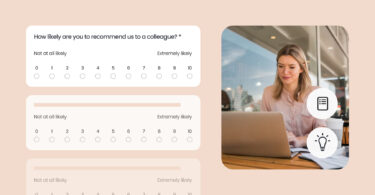According to the Harvard Business Review, businesses identified as loyalty leaders grow revenue 2.5x faster than industry peers. That’s why it’s important to ensure that your current customers are loyal to your business and your brand. In order to create loyal customers, you need to understand what’s working and what’s not with the relationships that you currently have. That’s where relationship surveys can help.
Table of contents
What is a relationship survey?
A relationship survey measures a customer’s overall relationship with a brand. Examples of relationship surveys include:
- A survey asking how likely you’d be to recommend a law firm to your friend.
- A survey asking how often you visit a restaurant.
- A survey asking for your overall level of satisfaction with an e-commerce company.
What is a transactional survey?
Transactional surveys are meant to measure customer satisfaction with specific touchpoints. Unlike a relationship survey, they are not meant to measure overall satisfaction. Examples of transactional surveys include:
- A survey about your last visit to the dentist.
- A survey from Uber asking you to rate your driver.
- A survey asking how easy it was to book your last appointment with your healthcare practice.
Should I use relationship surveys or transaction surveys?
You might be wondering whether your business should use relationship surveys or transaction surveys. Remember, both have their own strengths and weaknesses.
While a relationship survey is great for determining overall experience, a transaction survey can give you more specific feedback on how you can improve a particular touchpoint. While a customer might love your business, they might not be totally happy with a recent interaction with your customer service team. A relationship survey might not be able to uncover this but a transaction survey can.
So what do we recommend? Use both. Relationship surveys and transaction surveys can complement each other. By improving each one of your touchpoints, you’ll improve your overall relationship with the customer.
Differences in sampling
If you’re planning to send both relationship and transaction surveys, keep in mind that both types of surveys require different sampling methods. Transaction surveys require that you send the survey immediately after the transaction you want to measure took place. The longer you wait, the more customer’s memories will fade, and the less accurate the results you’ll get.
Because relationship surveys seek to measure how your customers feel about your brand overall, there’s less of an immediate need to seek out feedback. For relationship surveys, sample your entire customer base. This will give you a good idea of the overall level of satisfaction with your business.
Recommendations for relationship surveys
Want to get started sending relationship surveys? Here are a couple of recommendations to make sure that you’re getting effective feedback.
Types of questions to ask
Ask questions so that you can understand how your customers feel about your business as a whole. Here are a few sample questions that you can ask.
- How likely would you be to recommend (Business name) to family and friends on a scale from 0-10? With 10 being the most likely to recommend.
- How can we improve your overall experience with (business name)?
- In your own words, describe how you feel about (business name).
Typically, we do not recommend sending very long surveys to customers, as this reduces the likelihood that they will actually want to complete them. We’ve found that 3-7 questions are the ideal length for a survey.
How often should I send relationship surveys out?
Some articles recommend that you send relationship surveys twice a year. The idea is that you avoid sending too many surveys and annoy your customers.
Unfortunately, this approach isn’t great for collecting feedback you need to make constant improvements. Measuring overall experience on a regular basis allows you to fix problems before they become bigger issues. We recommend sending surveys as often as possible so that you can get constant data flowing in, which will help you deliver value to your customers as efficiently as possible. Just make sure that the survey software you’re using isn’t sending survey requests to the same customers over and over.
How to build stronger customer relationships
Once you’ve conducted your first relationship survey, you might be wondering how you can start improving your scores.
Identify potential areas of improvement
Chances are that there are some areas of your business that are weaker than others. Maybe you’re a dental practice with great dentists, but your patients aren’t happy with your front desk. This is where transactional surveys can give you important insights. Remember, the customer experience is made up of customer interactions and customer feedback across different touchpoints. Improving one or more touchpoints will lead to an improvement in the overall experience.
Keep a close eye on metrics
Once you’ve identified some potential areas for improvement, keep a close eye on the metrics from your relationship surveys. If your net promoter score (NPS)is going up, chances are that your efforts are paying off. However, if you see your NPS score go down, you might want to consider rolling back any changes that you’ve made.
Make sure that every part of your organization is onboard
It’s possible that different teams might have their own priorities. While this is to some degree inevitable, this can also lead to customer experience getting neglected. Make sure that every employee buys into the idea of creating a fantastic customer experience. Be sure that everyone has access to metrics like net promoter score and is involved in improving it.
How Birdeye can your relationship surveys
Want to start sending relationship surveys? Birdeye’s award-winning survey software can help. More than 150,000 businesses use Birdeye to collect feedback, build closer customer relationships, and improve customer experience.

Originally published









